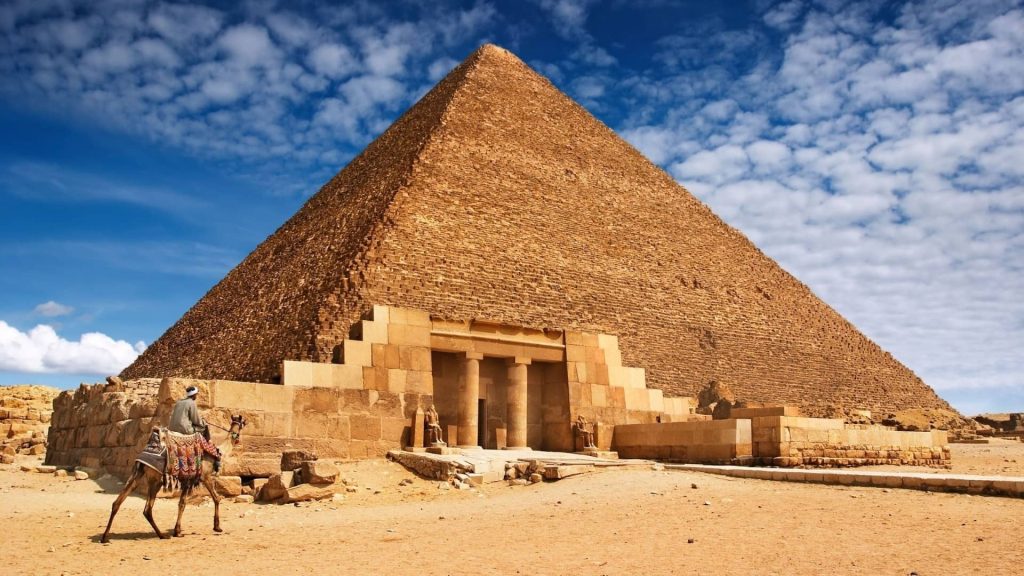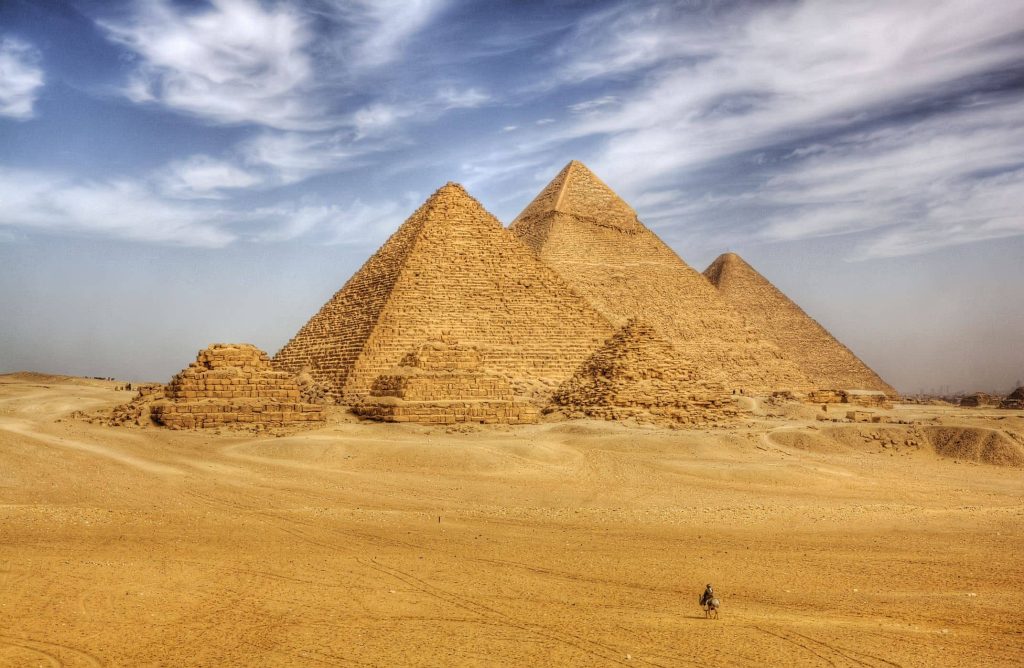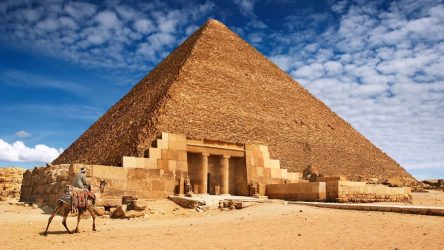The pyramids of Egypt, particularly the Great Pyramid of Giza, are among the most iconic landmarks in the world. A trip to these ancient marvels offers a glimpse into the rich history and cultural heritage of ancient Egypt. Whether you’re a history enthusiast or simply curious about these architectural wonders, this guide will help you plan an unforgettable trip.
Why Visit the Pyramids?

- Historical Significance: Built as tombs for pharaohs over 4,500 years ago, the pyramids are an enduring symbol of ancient Egyptian civilization.
- Architectural Marvels: The precision and scale of construction remain a mystery and a testament to ancient engineering.
- Cultural Experience: Visiting the pyramids offers insight into Egypt’s ancient beliefs, art, and society.
Top Pyramids to Visit
The Great Pyramid of Giza (Khufu’s Pyramid)
Access: Only a few chambers inside the Great Pyramid are accessible to visitors.
Entrance: The entrance is located on the north side, but it is higher up than the original ground level. You can enter through a narrow passageway.
The Grand Gallery: After entering, you’ll ascend a long passage known as the Descending Passage, which leads to the Grand Gallery—a high, sloped corridor with corbelled walls. This area is the most impressive and leads up to the burial chamber.
The King’s Chamber: This is where the sarcophagus of Pharaoh Khufu was found, though it is empty today. The chamber has a relatively low ceiling but is quite large in comparison to other chambers.
The Queen’s Chamber: This chamber, located lower in the pyramid, is not used for burial and its purpose is still debated. Some tours allow access to this chamber, but it is less visited than the King’s Chamber.
Air Shafts: These are narrow passageways that may have had a symbolic function or were designed to allow the pharaoh’s spirit to ascend to the heavens.
Pyramid of Khafre
Access: Visitors can enter the Pyramid of Khafre, but it is not as popular as the Great Pyramid. It is slightly smaller, but the internal layout is similar to Khufu’s.
Chambers: It also has a king’s burial chamber, but the passageways inside are not as expansive as in the Great Pyramid.
Best Time to Visit

The best times to visit Egypt are during the fall, winter, and early spring months, specifically from October to April.
Avoid the peak summer months (May to September)Temperatures can exceed 40°C (104°F) in many regions, making outdoor exploration uncomfortable, particularly in desert areas like the Valley of the Kings.
Special Events:
If you’re interested in cultural experiences, check for festivals or unique events, like the Sun Festival at Abu Simbel in February and October.
How to Get There From Cairo:
To travel from Cairo to the pyramids, you can take a taxi or use ride-sharing apps for convenience. Public transport options include microbuses and metro services connecting to Giza. Alternatively, book a guided tour that often includes transportation. The pyramids are located approximately 18 kilometers southwest of Cairo city center, making the journey quick and accessible for most travelers
Things to Do at the Pyramids

Visiting the pyramids is not just about admiring their grandeur; there’s a wealth of activities to immerse yourself in the history and culture of ancient Egypt. Here are some must-try experiences:
Explore the Pyramid Interiors: Step inside the Great Pyramid or the Red Pyramid to marvel at ancient architectural ingenuity. The narrow passages and chambers offer a mysterious and thrilling experience.
Visit the Great Sphinx: The iconic limestone statue of the Great Sphinx guards the Giza Plateau and is a must-see for its enigmatic history and symbolism.
Take a Camel or Horseback Ride: Traverse the desert sands on a camel or horseback for a unique perspective of the pyramids. These rides often provide opportunities for stunning panoramic photos.
Attend the Sound and Light Show: Experience the pyramids illuminated under the night sky as a captivating narration recounts their history and significance. The show is a blend of storytelling and visual spectacle.
Visit the Solar Boat Museum: Located near the Great Pyramid, this museum showcases a reconstructed ancient boat believed to have been used by Pharaoh Khufu for his journey to the afterlife.
Stroll Around the Giza Plateau: Take a leisurely walk around the plateau to appreciate the scale and beauty of the pyramids and their surroundings.
Essential Tips for Visiting

Tickets:
When visiting the pyramids, purchasing the right tickets is crucial to making the most of your experience. Tickets can be bought on-site or online through official platforms. Here are some key points to know:
exchange currency – Egyptian pounds
General Admission: This ticket grants access to the Giza Plateau, where you can explore the pyramids from the outside and visit the Great Sphinx. (200-300 EGP)
Interior Access Tickets: Separate tickets are required to enter the Great Pyramid, Khafre’s Pyramid, or Menkaure’s Pyramid. These can be limited, so it’s best to arrive early or book in advance. (400-500 EGP)
Combination Tickets: For those looking to explore multiple areas, combination tickets often include access to the Solar Boat Museum or other nearby attractions. (600-700 EGP
Pricing: Ticket prices vary for locals, tourists, and students. Carry a valid ID or student card for discounts.Up to 50% off for Egyptian nationals and students with valid ID.
Tips for Smooth Entry: Arrive early to avoid crowds, and be prepared with local currency for ticket purchases.
Guides:
- Private Tour Guides
These are personalized, one-on-one experiences where a guide can take you to famous sites like the Pyramids of Giza, Luxor, and the Valley of the Kings, or even more off-the-beaten-path destinations. They can tailor the itinerary to your interests, whether history, culture, or adventure.
- Group Tours
Group tours are a good option if you want a more affordable experience while still having a guide. These are often available through travel agencies and offer set itineraries with a group of people. They often include transportation and entry fees to the major sights.
- Specialized Guides
Archaeological Guides: These guides are experts in Egyptian history and archaeology, perfect for those who want in-depth knowledge about ancient Egypt.
Cultural Guides: Focused on modern Egyptian culture, lifestyle, and traditions.
Adventure Guides: If you’re interested in desert safaris, hiking in the Sinai, or diving in the Red Sea, these guides specialize in those experiences.
- Self-Guided Options
Many travelers prefer self-guided tours using apps or audio guides, which can be downloaded on your phone. This offers flexibility if you prefer exploring at your own pace. Some popular apps provide detailed information about Egyptian sites.
Nearby Attractions

- Egyptian Museum: Home to artifacts from ancient Egypt, including treasures from Tutankhamun’s tomb.
- Memphis: The ancient capital of Egypt, featuring statues and ruins.
- Solar Boat Museum: Houses a reconstructed boat believed to have been used by Khufu.
- Khan El Khalili Market: Explore Cairo’s vibrant bazaars for souvenirs and traditional crafts.
Accommodation options
Egypt offers a wide range of accommodation options to suit every budget and style. Luxury hotels and resorts are abundant, especially in Cairo, Luxor, and along the Red Sea coast, offering stunning views and world-class amenities.
Budget travelers can find hostels, guesthouses, and affordable hotels in major cities and tourist areas. For a unique experience, consider staying in desert camps or Nile River cruises. Many accommodations also provide tours and excursions to help explore Egypt’s ancient wonders
Sustainable Travel Tips
Sustainable travel reduces your environmental footprint while promoting responsible tourism. Choose eco-friendly transportation like trains or cycling. Pack light with reusable items to minimize waste.
Stay in green accommodations and support local businesses. Respect nature by following Leave No Trace principles. Sustainable choices enrich your journey and protect the planet.
Conclusion
A trip to the pyramids is a journey through time, offering a deep connection to one of the world’s greatest civilizations. With careful planning and a sense of adventure, you can make the most of your visit to these extraordinary landmarks. Whether marveling at the Great Pyramid or discovering lesser-known treasures in Saqqara and Dahshur, the pyramids promise an experience that will stay with you forever.
Frequently Ask Questions
Visiting the pyramids in Egypt is generally considered safe for tourists, especially when traveling to well-known sites like the Pyramids of Giza near Cairo. The Egyptian government has implemented security measures to protect these areas, and many travelers visit without incident. However, it's important to stay informed and take certain precautions to ensure a safe and enjoyable experience.
Recent Updates on Travel Safety in Egypt - The Times
No, you cannot go inside the Great Sphinx of Giza. While the Sphinx is one of the most iconic monuments in Egypt, it is solid for the most part and does not have an accessible interior. There are some chambers and tunnels within the structure, but these are not open to the public and are primarily of archaeological interest.
people are not allowed to touch the Great Sphinx of Giza. The Sphinx is a protected monument, and visitors must stay behind designated barriers to help preserve its condition. Strict regulations are in place to prevent damage to the ancient structure caused by physical contact, erosion, or wear.
Egypt stopped having kings in 1953 when it was declared a republic, ending centuries of monarchy. The change followed the 1952 Revolution, led by the Free Officers Movement, a group of nationalist military officers.

Owen Samuel is a Destination Manager based in California, known for his expertise in creating unforgettable travel experiences. With a deep passion for tourism and local culture, he helps travelers discover the best places around the world.










